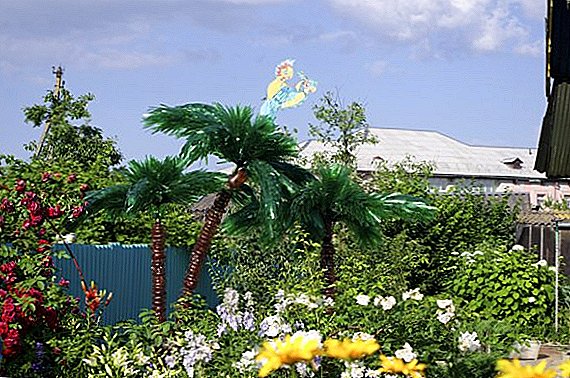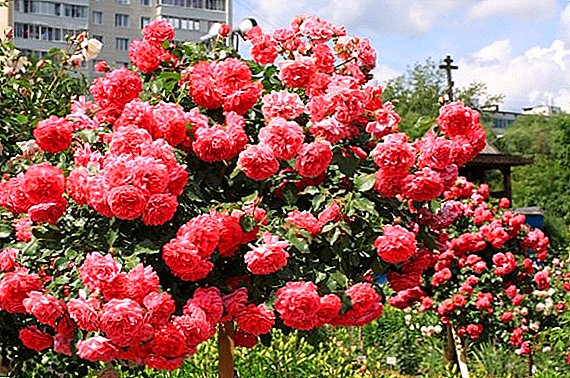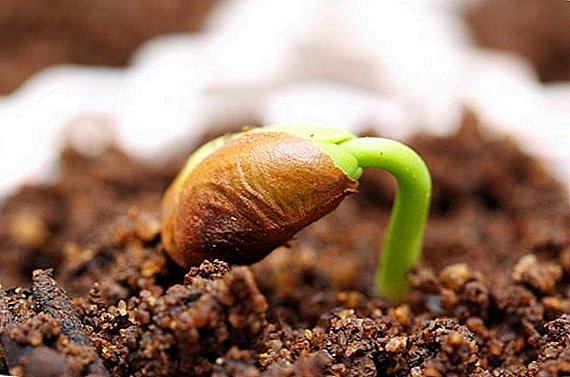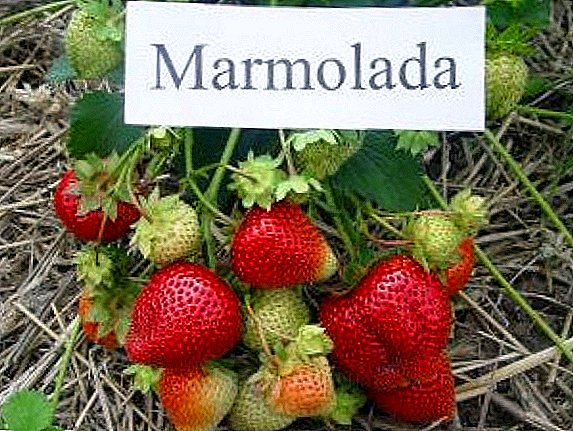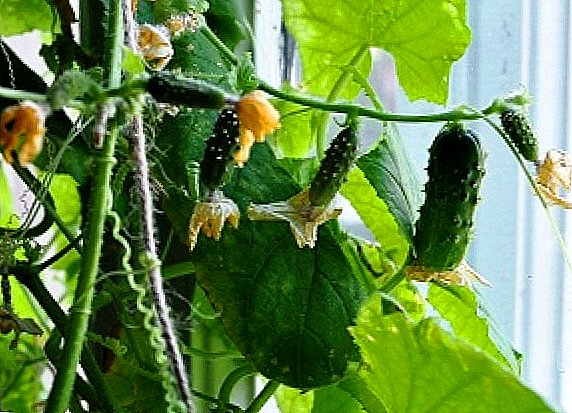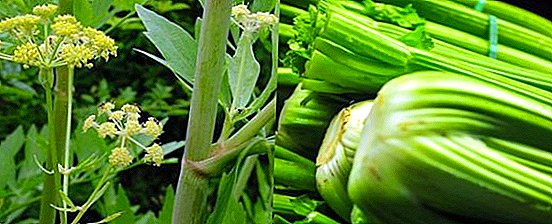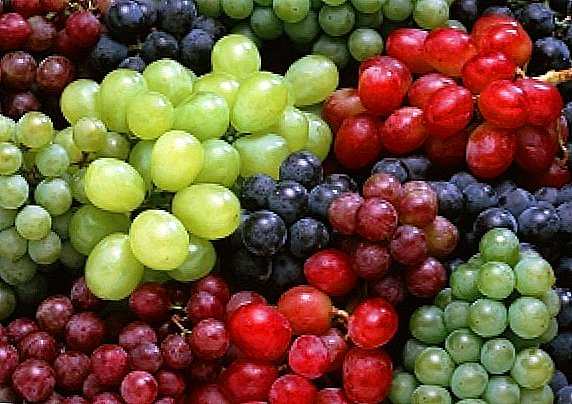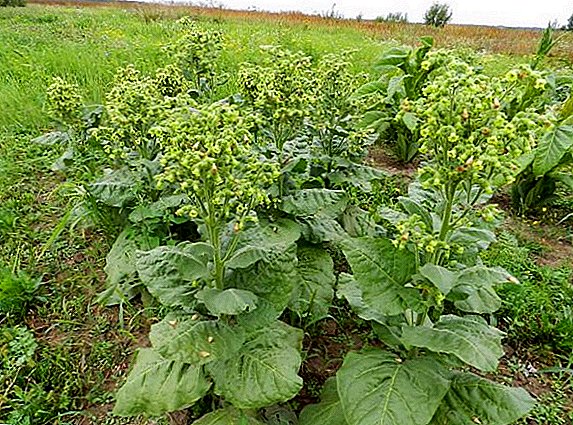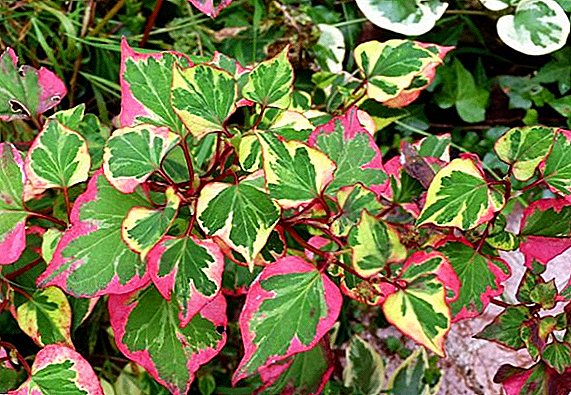 If you have ever seen a hauttyunia, you will certainly want to plant it on your site, because it is difficult to resist its beauty and originality. But in the process of growing you may face some difficulties. To avoid them, familiarize yourself with the basic rules for growing and caring for a plant.
If you have ever seen a hauttyunia, you will certainly want to plant it on your site, because it is difficult to resist its beauty and originality. But in the process of growing you may face some difficulties. To avoid them, familiarize yourself with the basic rules for growing and caring for a plant.
Description
Huttuynia (guttuinia, Houttuynia) is a perennial herb that belongs to the family Auruta. It can reach a height of 30 cm. The flower was named in honor of a scientist from Holland by the name of Houttein, who studied the genus. Until recently, only the heart-shaped hauttuynia (Houttuynia cordata) was known, but in 2001 in China, they discovered the hauttunia emeiensis species (Houttunyia emeiensis), which has not yet been studied.  The roots of the plant are thin, with nodes from which grow straight or slightly curved bare stems. The leaves are heart-shaped, oblong, alternately arranged on short cuttings. The color of the leaves is green with yellow, red, beige, white, pink stains. On the surface shoots appear in the second half of May.
The roots of the plant are thin, with nodes from which grow straight or slightly curved bare stems. The leaves are heart-shaped, oblong, alternately arranged on short cuttings. The color of the leaves is green with yellow, red, beige, white, pink stains. On the surface shoots appear in the second half of May.
Read also about such unusual flowers as sundew, passionflower, nepentes, orchis, hoya, camellia and amorphofallus.The plant blooms at the end of summer with bisexual flowers, similar to small corn cobs, about 3 cm high. Four white petals are arranged in one or several rows in a circle below. The fruits have soft thick walls without pulp inside, there are many spherical seeds. The natural habitat of the plant is Asia. In countries where rice is grown, it is unsuccessfully struggled with, as with a difficult weed, displacing rice. The same problem exists in the tea plantations of Transcaucasia.
Kinds
Heart-shaped hauttyyniya includes these types:
- Chameleon has leaves with different shades of yellow and red on a green background and flowers with petals in one row.
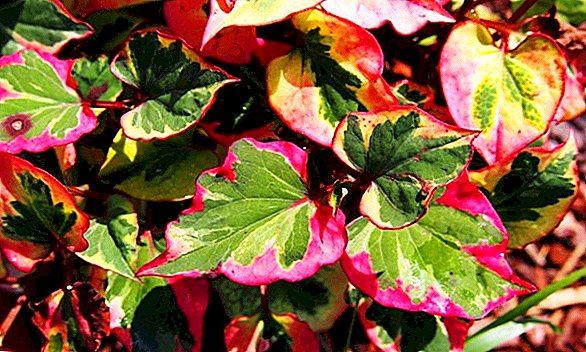
- Captivity. The petals on the flowers they are arranged in several rows, the leaves are green.
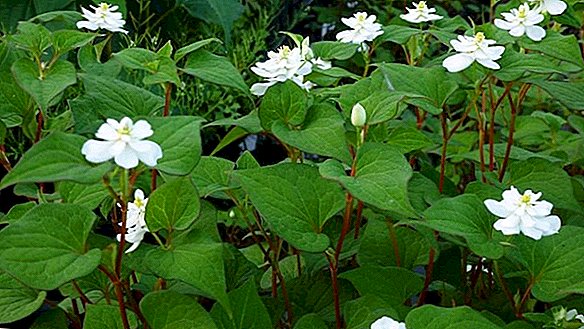
- Variegata It grows bright leaves with green, yellow, red, pink color, and few flowers.
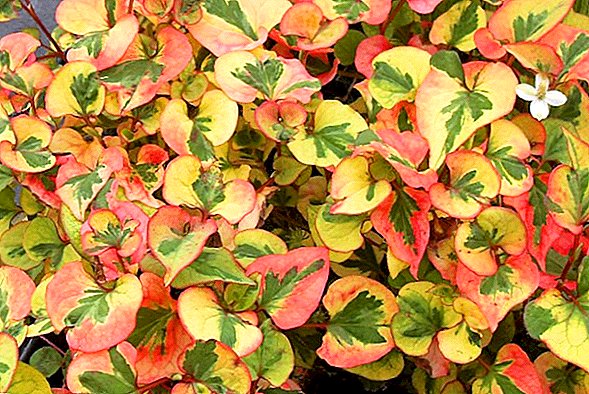
- Tricolor (Pied Piper). The main color of the leaves of the plant - different shades of yellow, green - in the form of veins.

Plant Care
Despite the fact that the plant comes from warm edges, in our latitudes it is not very demanding to care.
Lighting
Although the flower does not disappear in the shade, the best place for it is the sunny side. For beauty, this plant needs to see the sun at least 5 hours a day.
Important! If you plant a hauttuynia in a shaded place, its leaves will lose a bright color and become green.
Temperature
High summer temperature is not terrible to the plant, if you ensure timely watering. Winters with heavy snow are highly desirable, as in such conditions, the hauttunia can winter at -25 ° C. In a snowless winter, the maximum temperature at which it can survive is -18 ° C. As soon as the temperature is zero, the leaves die off the plant. 
The soil
Houttuynyu planted in the prepared substrate, mixing loam and peat soil in a ratio of 1 to 1. However, it is able to grow in marshy soil, in coastal water, on a rocky hill.
Gardeners often grow flowers such as Surfinia, Begonia, Pelargonium, Calibrachoa, Marigolds, Dahlia, Hortensia, Zinnia, Lobelia, Chrysanthemum, Geranium, Peony, Lily and Tulip.
Watering
This flower loves moisture, so it needs frequent watering (in hot summer - at least every other day). However, if you put him near the water, this need disappears.
Humidity
The flower likes moist soil, it can be planted on the shore of a pond or in shallow water, to a depth of 5 cm, however, in the frosty regions, the latter option is not suitable, as the plant freezes. Moist air around it can provide wet compost scattered around. 
Top dressing
You need to feed the hauttyunia with fertilizers in the form of fish, bone, phosphorite or horn flour, which do not dissolve in water, but crumble around, slowly absorbing into the soil and feeding the plant. Another option is fertilizer in the form of resin-coated granules. They are scattered around in the spring, and during the summer they are gradually absorbed into the soil.
Important! Do not apply fertilizer with a large amount of nitrogen to the soil around the hauttuynia, this affects rot and bad winters.
Pruning
Cut the plant in the spring - cut overgrown roots, cut off parts of the roots for transplantation, and in adult plants cut cuttings. Cutting off the foliage is not necessary, the leafy carpet will still look very neat, even if you cannot keep it in the right place. 
Wintering
To help the hauttyyny easier to transfer the frosty winter, it can be sprinkled with compost, dry leaves, sawdust, spruce or pine branches, or covered with a special covering material that is sold in stores with goods for gardening. After the snow falls, you can sprinkle them as a supplement.
Another option is to plant the plant in a large container and bring it to the basement or garage for the winter. If it seems to you that your hauttyuniya has not survived the winter, do not rush to dig it out, it tends to give out late shoots, so it may well please you with the beauty of the foliage.
Restriction of growth of rhizomes
Houttuynia has creeping roots that grow in different directions. If you do not follow its growth, it can spread throughout the site. In order to prevent this, plastic, metal or rubber fences should be buried in the ground so that they cover a depth of 30 cm. Also, the flower can be planted in a large pot, in water, an old leaky bucket. Consider that its roots can spread over the surface. 
Did you know? Plants prevail among all living beings on the planet, the number of their species - over 375 thousand.
Breeding
Propagated hauttyuniyu division of rhizome or cuttings.
Rhizome divisions
It is best to propagate hauttyuniya in this way in early spring, then before the winter she will be able to gain strength. During this period, the plant will not have time to "wake up" after wintering.
We offer you detailed instructions:
- Carefully remove the top layer of earth (before the root system).
- Find the knot at the root and cut off the tip of the root with it (you can shovel).
- Push the shovel under the root and lift it out of the ground. Shake off
- If the root is too large, cut, but the bundle should remain.
- The soil is rich in clay and sand, mix with peat and pour into a large pot or other container.
- In a hole 10 cm deep, lower the root and sprinkle with soil. Pour over.
- When the leaves appear, plant the flower in the allotted place with the pot to keep it in one place.

Cuttings
Cuttings are cut when the hauttyunia sprouted to a sufficient height (approximately at the beginning of summer). If, for any reason, grafting has occurred later, the young plant needs to be hibernated in the room, otherwise it may freeze. You can cut the stalk with a single leaf or cut between the leaves. The length should be between 2.5 and 4 cm.
Next, you need to act this way:
- The segment is placed in a small glass and pour water so that the level does not exceed 1/3 of the plant. As the evaporation of water must be poured.
- If the cutting was cut with a sheet, put the glass in the light, if without a sheet - in a dark place.
- When the roots grow, pour the soil into the prepared container and plant so that they are submerged to a depth of 10 cm. Water.
- Plant the plant with its capacity in the prepared place.
Important! With any method of reproduction do not plant more than 16 plants per 1 square. m
Application
Houttuynyu used in cooking, for registration of the dacha, for the treatment of various diseases as an unconventional tool.  In garden design, hauttuyny is applied as follows:
In garden design, hauttuyny is applied as follows:
- to brighten up the empty places along the edge of the pond;
- for registration of stony hills;
- for registration of a site near a fence, footpath or house;
- in pots to decorate the terrace or window sills.
- as a power restoring tea;
- with inflammations;
- as a diuretic;
- from wounds and purulent inflammations on the skin;
- to liquefy sputum in the airways;
- for receiving essential oil;
- with prostatitis;
- to strengthen the immune system;
- with hemorrhoids.
Such plants as astilba, delphinium, lupine, stevia, tricyrtis, phloxes, orebeckia, echinacea, iris and yarrow can also be attributed to perennial plants.
Difficulty growing
Houttuynia does not require special care, but when it is grown there may be some difficulties:
- Having planned the location of various plants during the design of the site, after wintering you can find a hauttuynia elsewhere. To avoid this, planting a flower, dig in the limiters for the rhizome, or plant in any container.
- The colorful leaves of the plant turned pale green. This means that the flower is not enough sunlight. He must be transplanted or removed that casts a shadow on him.
- White spots appeared on the foliage, the color faded. Probably the bright sun burned her. If it is not possible to dispel sunlight, water and spray the leaves more often.
- In spring, all the plants in the flowerbed bloomed, and instead of hauttyynii - emptiness. This happens because its shoots appear in the late spring and early summer. Up to this point, to brighten the void, you can plant snowdrops.
- The flower began to grow strongly. This means that you overdid it with fertilizers. A transplant can help, watering with a solution of lime, adding sawdust or sand, plentiful watering with water.
- After wintering the plant died. This can happen if the fertilizer for the plant was a lot of nitrogen, or the reservoir in which it grew, froze. Carefully pick up fertilizer, wrap a flower or bring it into the room for the winter.

Diseases and pests
Like other aquatic plants, hauttyuniya, planted on the edge of the reservoir, may be affected by pests:
- Bloodworm - small worms red, do not cause significant damage, but can damage the roots. The means to combat it are fish.
- Mosquito krikotopus - its small larvae devour the leaves. You can trim the gnawed leaves and burn.
- Water fire - beige in a dark strip of caterpillar length 2.5 cm, eat the leaves. They can be swept into the water to feed the fish.
- The caddler is its larvae in the form of yellow caterpillars, which make holes in the foliage and flowers. Collect them and throw them to the fish.
- Prudovik ordinary - a large colony of these snails can eat the foliage. Usually they are collected manually.
- Aphid - 6 mm light green or brown insects that weaken plants. To combat them, it is best to get insects that destroy them - hovering, horsemen.
- The midges, their larvae, are difficult to distinguish with the naked eye, but the traces of their vital activity in the form of holey leaves are striking. Such foliage needs to be collected and burned.
Did you know? Aphids release sweet dew that ants love, so the latter often contain aphids in their anthills and feed them with foliage.

For aquatic plants such diseases are characteristic:
- Root rot - the affected roots begin to rot, after which the flowers die. A way out of this situation can be a thorough check of the roots of the hauttyunia before planting and discarding the blackened and soft, otherwise you will have to drain the water and clean all the plants.
- Leaf spot - first brown spots appear, then the leaves die. The way to fight is timely cutting off the infected leaves.
Feedback from network users








